 Picture source: Pixabay
Picture source: Pixabay
In an ideal office environment, emails are one most utilized means of communication. Senior staff can send group messages to their team members with a single email. Internal communication is not all there is to offer, as the email also symbolizes an essential part of marketing for companies. In addition to brand image presentation, email marketing can also be used in human resources to build the company’s reputation and liven up recruitment processes. We will first review the key aspects that need to be in place for your email marketing to be successful and further list how your company’s newsletter could use Email Marketing for HR.
Overview: What to Set Up First?
Before the marketing and HR teams can work together to send out all of the content they want with the newsletter, some initial plans need to be put in place and the technical side of the emails reviewed. Let’s take a look – what kind of preliminary work needs to be done?
1. Build Your Mailing List
Building a robust email list enhances your campaign’s reach. This is not the easiest task, but there are some tricks you can use to make it grow faster. For instance, you can encourage prospective subscribers to join your list by offering them some benefits from making the subscription. It could be free tips, the latest updates, or anything else they deem valuable. If you have an online store, you could offer them a discount on their next purchase. Before receiving these bonuses and practical gifts, they must subscribe to the newsletter. Share information about your newsletter with your social media followers, including info about the benefits that come with subscribing. And last but not least – Ensure your website has a prominent newsletter call-to-action (CTA) button. You can also draw attention to this by adding a popup that invites the webpage visitor to subscribe to your newsletter.
2. Recognize and Focus on Your Target Audience
After you have successfully lured people into subscribing to your newsletter, the next step is to live up to your promises, in order to keep them as a member. Subscribers expect you to provide them with quality content. To continue meeting these expectations, you need to think about their profile and needs. Who are the subscribers to your newsletters?
To find this out, we encourage you to team up with your colleagues, in order to map the different profiles of your regular email subscriber. Put your heads together – who is the person who wishes to use your products or services? What types of people could your brand image attract, and who does your current way of communicating really speak to? In what age group does the average reader of your newsletter belong, what are their interests, and – especially interesting for HR – what’s their specialization and employment status?

Subscribing to a newsletter must be a well-presented task that is easy for people to complete, so you can’t ask for demographics here. However, you can use other marketing channels for analysis, such as taking a look at the statistics on your Facebook page. In order to find out what specifically affects the already present subscribers of your newsletter, you can run A/B tests. To help you with email marketing analytics, read more specifically about it in our previous article and find all the keywords you need to know.
By classifying your brand followers, you get the required insight in order to plan your future newsletters. The more clearly you understand your mailing list, the more content you can create to meet their needs.
3. Create a More Personal Touch
You understand that your competitors also have a mailing list. Maybe they’ve already considered the previous steps. So what differentiates you from them? The answer is your tone of communication. First, you need to personalize your emails to make them relevant and feel especially for your subscriber when they read them. Several research pieces have helped prove that personalized emails have a higher open and conversion rate than non-personalized emails.
If possible, communicate with your newsletter subscriber by using their name when you address them. Design advertisements for various products and services according to the previous interest of a particular subscriber. Send different automatic emails according to some previously performed activities by the subscriber. Speak in the voice of your brand, but use a warmer and more personal tone when talking to your subscribers.
4. Apply Mobile Optimization
A very large proportion of people check their email via mobile, and this percentage is on the rise due to its convenience in today’s fast-paced environment. Have you ever run into an email or a website that is obviously set up to be viewed merely on a computer? This is definitely annoying while using your smartphone, and if you are in a hurry or think the page is broken, you will close it and find another company’s website or newsletter instead. Therefore, it is crucial to optimize your emails, i.e. make them easy to read in mobile view.

If you look at your email analytics and examine the campaign information on your campaign page, you can convince yourself of the importance of the mobile view. More specifically, if you check out how many people read your emails on their mobile phones. Learn more about mobile view statistics and how to optimize your messages for mobile here.
HR Stories in Email Marketing
As mentioned above, the most important part of good marketing is how you communicate directly with your subscribers via email. Now we get to the most important thing – what kind of content you treat your subscribers with. Finding content worth sharing can be a daunting task during some slower periods. To get inspiration in content creation for your email marketing, read from one of our previous blog posts. In this article, we’ll delve deeper into the question that fascinates us most – how to use the newsletter to not only advertise your products and services but also to bring benefit to the human resources division?
1. Recognition of Your Employees
There are definitely people in your company who stand out for their contribution and deserve recognition for it. If the valued employee agrees, you may also thank them through your recognition letter or your company newsletter. For example, you can plan to publish a thank you story for World Employee Recognition Day – the first Friday in March. Or if there are a lot of good employees and your team is large, why not do it more often than once a year. In this way, you emphasize that your company notices the efforts made and is proud of its employees. By doing this through a newsletter, you are showing it not only to your employees themselves but also to your brand followers – newsletter subscribers. Keep in mind to also include remote freelancers that may be part of the team so they will feel acknowledged and not left out.
Almost every type of reader is interested in an individual approach and true-to-life content – whether they are a subscriber to the newsletter of a handicraft furniture store, a beauty salon, or a start-up company. It is always good to know who are the people behind a product or service. It creates a sense of security and knowledge that you support real people through your purchases and strengthens trust in the brand.
2. Do You Spend Time With Colleagues?
Have you just returned from super fun company summer days or have you recently visited a ceramics training with the team? Or maybe you organize in-house sports days at the initiative of your employees, thus additionally promoting a healthy lifestyle? No matter what you do with your team, be sure to share exciting stories and images in the company’s marketing channels. In addition to sharing pictures on social media, you can also add a fun picture to your company’s newsletter.
In addition to private events; various anniversaries and holidays offer a particularly sweet opportunity to share your employees’ activities with your newsletter subscribers. For example, you can send Christmas wishes from all of your company’s employees to your subscribers and add, for example, a picture taken of your team on the fun Ugly Christmas Sweater Day. Such content is likely to be even more welcomed by your readers who are already feeling the holiday spirit.
When sharing content, you don’t have to limit yourself to pictures, you can also think of making a high-spirited video. It can be shared as a souvenir for colleagues, as well as an exciting glimpse for everyone who is interested in the company, potential future employees included.

The contemporary job seeker does not make decisions based solely on the salary they receive for their work. In addition, a very important aspect is the bonuses offered by the company; including time spent well with colleagues. Sharing moments of employee happiness is an extremely effective way to confirm that a company or brand and its employee are not only bound by a contract, but also by deeper solidarity and warm relationships.
3. CTA button for career stories and job postings
Is there a subpage on your website where you showcase the vacancies in your company? For the HR department, such a page is extremely important to find the right employees for your team. Only people who have a serious interest in working for the company will land on the vacancy page. Also, only those who are interested in your brand will subscribe to your newsletter. Add a CTA button to your newsletter that directs the reader to the vacancy page. This will broaden your search and increase the chances of finding suitable candidates.
Think about how actively have you formed the image of your company in terms of HR-related matters. In other words, how much information can people find about the bonuses and actual development opportunities that come along with working for your company? To reflect this, you can upload interviews with your company’s employees and ask them to talk about their journey in the company. You can add it to your website and then share these pages via CTA-s in your newsletters. The interview should ideally be natural, upbeat, and presented in a freer form – you can leave the formal tone for official job advertisements. Telling these stories is an extremely effective way to “spread the word” about what an employee’s real development story can look like in your company. Of course, this is since the information obtained directly from an employee is inherently more reliable for the reader.
4. Vacancies in the Email – to Add or Not to Add?
You can try to add a specific job ad directly to the body of your newsletter, preferably at the end part of the email. It depends on the company’s specialization, but traditionally, newsletter readers are primarily interested in your various products and services. However, if you have already occasionally shown them inspiring stories about your amazing work team, you have already brought the reader closer to your brand. Thus, if you’ve been building your image for a while now, you can announce at the end of your newsletter that you’re in search of a new and cherished colleague. Don’t be afraid to draw more attention to it and excite your readers by announcing a contest, for example! You can describe it in your email in a short and more fun way and direct those interested to the official job advertisement page.

5. A Separate Newsletter About the Company’s Activities
Last but not least – if it’s relevant to your industry and you’re sure your subscribers want to know more about your business, why not create a separate newsletter for HR purposes? Instead of directly advertising your products and services, you can share stories about the company’s success story and the people who are the force behind it. However, keep in mind to share only the best and most interesting content and send out this message less often – for example, once a quarter. In this way, topics related to brand image and HR remain fresh for your readers. If you make these emails repetitive in your email marketing plan and share enough different and positive content, newsletter subscribers will happily anticipate the next ones.